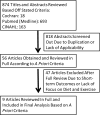Diet and exercise interventions following coronary artery bypass graft surgery: a review and call to action
- PMID: 24875979
- PMCID: PMC4260396
- DOI: 10.3810/psm.2014.05.2064
Diet and exercise interventions following coronary artery bypass graft surgery: a review and call to action
Abstract
Coronary artery bypass graft (CABG) surgery has been used for the treatment of coronary artery disease (CAD) for approximately 50 years, and has been performed on millions of people globally. However, little is known about the impact of diet and exercise on long-term outcomes of patients who have undergone CABG surgery. Although clinical practice guidelines on the management of this patient population have been available for approximately 2 decades, evidence regarding secondary prevention behavioral interventions, lifestyle modifications and self-management to slow the progressive decline of CAD, reduce cardiac hospitalizations, and prevent reoperation remains virtually absent from the literature. Diet and exercise are modifiable factors that affect secondary CAD risk. This article reviews the relevant current literature on long-term diet and exercise outcomes in patients who underwent CABG. The limited available literature shows the positive impacts of exercise on psychosocial well-being and physical fitness. Current evidence indicates diet and exercise interventions are effective in the short-term, but effects fade over time. Potential age and sex differences were found across the reviewed studies; however, further research is needed with more rigorous designs to replicate and confirm findings, and to define optimal management regimens and cost-effective prevention strategies.
Figures
Similar articles
-
[The comparative analysis of the influence of the supervised exercise training and home-based exercise training on the psychological status of the following coronary artery bypass grafting].Vopr Kurortol Fizioter Lech Fiz Kult. 2017 Dec 28;94(6):10-17. doi: 10.17116/kurort201794610-17. Vopr Kurortol Fizioter Lech Fiz Kult. 2017. PMID: 29388927 Clinical Trial. Russian.
-
[The short- and long-term motivational effects of a patient education programme for patients with coronary artery bypass grafting].Rehabilitation (Stuttg). 2008 Aug;47(4):219-25. doi: 10.1055/s-2007-1004598. Rehabilitation (Stuttg). 2008. PMID: 18704871 Clinical Trial. German.
-
Prognostication in 3-vessel coronary artery disease based on left ventricular ejection fraction during exercise : influence of coronary artery bypass grafting.Circulation. 1999 Aug 31;100(9):924-32. doi: 10.1161/01.cir.100.9.924. Circulation. 1999. PMID: 10468522
-
Effectiveness of nurse-led cardiac rehabilitation programs following coronary artery bypass graft surgery: a systematic review.JBI Database System Rev Implement Rep. 2018 Dec;16(12):2304-2329. doi: 10.11124/JBISRIR-2017-003565. JBI Database System Rev Implement Rep. 2018. PMID: 30204710
-
Reoperation for coronary artery disease.Circulation. 1985 Dec;72(6 Pt 2):V59-64. Circulation. 1985. PMID: 3905058 Review.
Cited by
-
Dietary inflammatory index: a potent association with cardiovascular risk factors among patients candidate for coronary artery bypass grafting (CABG) surgery.Nutr J. 2018 Feb 13;17(1):20. doi: 10.1186/s12937-018-0325-2. Nutr J. 2018. PMID: 29439738 Free PMC article.
-
Long-Term Caloric Restriction Improves Cardiac Function, Remodeling, Adrenergic Responsiveness, and Sympathetic Innervation in a Model of Postischemic Heart Failure.Circ Heart Fail. 2018 Mar;11(3):e004153. doi: 10.1161/CIRCHEARTFAILURE.117.004153. Circ Heart Fail. 2018. PMID: 29535114 Free PMC article.
-
Validation of the Greek Cardiovascular Diet Questionnaire 2 (CDQ-2) and Single-Center Cross-Sectional Insights into the Dietary Habits of Cardiovascular Patients.Nutrients. 2025 May 12;17(10):1649. doi: 10.3390/nu17101649. Nutrients. 2025. PMID: 40431389 Free PMC article.
-
Impact of South Asian Ethnicity on Long-Term Outcomes After Coronary Artery Bypass Grafting Surgery: A Large Population-Based Propensity Matched Study.J Am Heart Assoc. 2016 Jul 22;5(7):e003941. doi: 10.1161/JAHA.116.003941. J Am Heart Assoc. 2016. PMID: 27451460 Free PMC article.
-
Feasibility of a Facebook Intervention for Exercise Motivation and Cardiac Rehabilitation Adherence: Study Protocol.JMIR Res Protoc. 2017 Aug 18;6(8):e162. doi: 10.2196/resprot.7554. JMIR Res Protoc. 2017. PMID: 28821473 Free PMC article.
References
-
- Patel MR, Dehmer GJ, Hirshfeld JW, Smith PK, Spertus JA. ACCF/SCAI/STS/AATS/AHA/ASNC/HFSA/SCCT 2012 Appropriate Use Criteria for Coronary Revascularization Focused UpdateA Report of the American College of Cardiology Foundation Appropriate Use Criteria Task Force, Society for Cardiovascular Angiography and Interventions, Society of Thoracic Surgeons, American Association for Thoracic Surgery, American Heart Association, American Society of Nuclear Cardiology, and the Society of Cardiovascular Computed Tomography. Journal of the American College of Cardiology. 2012;59(9):857–881. - PubMed
-
- Arora R, Sowers JR, Saunders E, Probstfield J, Lazar HL. Cardioprotective strategies to improve long-term outcomes following coronary artery bypass surgery. Journal of cardiac surgery. 2006 Mar-Apr;21(2):198–204. - PubMed
-
- Hillis LD, Smith PK, Anderson JL, et al. 2011 ACCF/AHA Guideline for Coronary Artery Bypass Graft Surgery: a report of the American College of Cardiology Foundation/American Heart Association Task Force on Practice Guidelines. Circulation. 2011 Dec 6;124(23):e652–735. - PubMed
-
- Lifestyle and risk factor management and use of drug therapies in coronary patients from 15 countries; principal results from EUROASPIRE II Euro Heart Survey Programme. European heart journal. 2001 Apr;22(7):554–572. - PubMed
Publication types
MeSH terms
Grants and funding
LinkOut - more resources
Full Text Sources
Other Literature Sources
Medical
Miscellaneous

